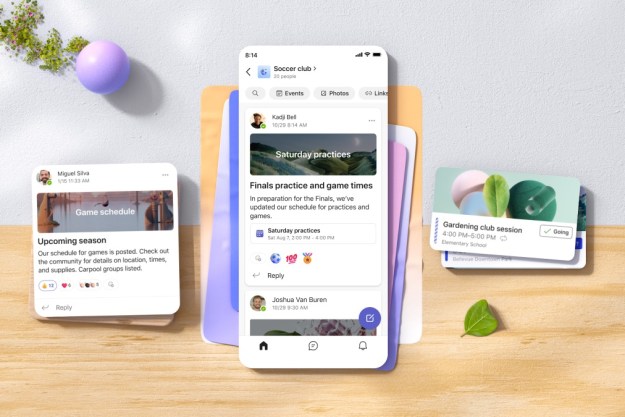If you’re one of the 145 million daily active users in Microsoft Teams, you’ve probably relied on the messaging client dramatically more in the past year than ever. As most of us have found, replacing your physical office with a messaging application like Teams poses some limitations on collaboration.
That’s why Microsoft announced Collaborative Apps for Teams back at its Build developer conference earlier this year. Those apps were meant to allow for a more customized, powerful, and collaborative experience of Teams.
At the Inspire 2021 partner conference, Microsoft has announced a big update for these collaborative Teams apps, as well as a new collection of Collaborative Apps partners like SAP, C4C, Salesforce, ServiceNow, and Workday. I had the chance to sit down with Nicole Herskowitz, a general manager for Microsoft Teams, and talk about how these new apps transform the Teams experience.
Seeing the change

To kick off our conversation, Herskowitz talked about how Microsoft is seeing the realities of remote work, and how partners are building and interacting with applications. She tells me that even though Teams is the platform for people to work, learn, and collaborate, it is evolving into something more than that.
“Teams has really evolved into what we say, a digital workspace that really brings together business processes and applications into one place. Teams has become an organizing layer because of the number of people using the product in their work,” said Herskowitz.
Partners are building all kinds of Teams apps that look and feel different. Since the start of 2020, monthly active users of ISV and custom app-built solutions on Teams has grown nearly 10 times, per Microsoft.
Herskowitz says that in the past, Microsoft saw a focus on productivity apps, but now there’s a new class of apps where collaboration is at the core of the experience. These are what Microsoft calls Collaborative Apps, where synchronous asynchronous collaboration comes into play. Basically, think of apps that pull and leverage real-time meetings, ad hoc messaging, and the business processes or even structured data that organizations rely on.
Diving deeper into the enhanced collaborative Teams apps

Curious to hear about what these enhanced collaborative Teams apps can do for businesses, I asked Herskowitz to dive a bit deeper. She used the new Service Now Collaborative App in Teams as an example.
In the past, Herskowitz says, you would need to minimize Teams when using something like Service Now. This would then take you out of your flow of work and interrupt your process. Now, with the Service Now Teams Collaborative App formed in partnership with Microsoft, businesses can rethink their incident response management process. Everything can now be done in Teams without switching applications — say in the situation where an employee at a company finds that a PC isn’t working correctly, or even automating password resets.
With the integration with the Service Now virtual agent, that employee can have conversations and open a support ticket within a Teams channel or chat, with the information being captured in Teams but stored in Service Now. The Virtual Agent in Teams can even hand things over to a Live Agent, who will tap into Teams and the Microsoft Graph to respond to questions and find the solution.
“Teams is where I spend my day. I now can just solve problems for an end-user right within Teams, in the way the company wants to organize it. Whether it’s virtual live agents, that whole workflow can be streamlined right there,” said Herskowitz.
And these Collaborative Apps are working, too. Customers like Levi Strauss have been able to form rapid lines of communication between agents and employees. Deflection rates cases are over 50% and the internal customer service rate (CSAT) for their employees surged to 100%, I was told.

But that’s just one app. Herskowitz mentioned other big examples from Microsoft’s partners. SalesForce is another. It will allow access to customer records in the context of a chat or a channel. Then there’s also Confluence Cloud by Atlassian, which next month will let you take notes in the side panel of a meeting window, take action on items and make decisions with code snippets, mentions, and tables.
Other examples cover Workday in Teams, which will release an update in the next month to add a new Teams tab experience to help users complete workflows and tasks via a clickable UI. Even monday.com is coming to Teams. It will incorporate project building blocks such as boards, views, charts, and automations into the flow of everyday work in Teams channel, chat, and individual context
“It’s these collaborative acts that really kind of bring together the best of what, you know, teams and the Microsoft cloud has to offer with these other applications that have, you know, either key scenarios or workloads that they support,” said Herskowitz.
Why are partners building these apps and what are the benefits?

I also wanted to know why Microsoft is opening up Teams to developers and partners to create more Collaborative Apps. Why are they seeing so much success in convincing developers to put in the work? Herskowitz says it’s about a couple of different things.
The first is that Teams has a big reach with 145 million daily active users. The second is that Microsoft is making it easier for developers. Microsoft allows developers to leverage existing skills so they can integrate existing apps with JavaScript web technologies and the Teams SDK — with one Teams app working on all devices where Teams is available.
All of this is why Microsoft is allowing partners to sell their apps within Teams via the AppSource or the Teams Admin Center this summer. This allows companies to monetize their offerings. It also means that someone like you or me can purchase an app subscription through Teams and invoice the company for it — or use a credit card.
Microsoft is even reducing marketplace fees, from the industry-standard 20% to only 3%, so ISV’s can make more money. It’s a change that is happening across all of Microsoft, on the company’s other app stores on Windows and Xbox.
Herskowitz mentioned that this is just the start. Obviously, right now these Collaborative Apps are for enterprise users, but Teams is always a changing platform for Microsoft — so don’t count anything else that’s new out just yet.
“It’s about how do I make my business run better by having those mission-critical applications integrate with these Teams experiences. That’s really the focus right now, but we’ll continue to, you know, evolve teams as a platform to support all types of scenarios beyond just kind of commercial or enterprise and you’ll find the apps the same way as you normally would through the Teams app store.”
Other Teams updates

My conversation with Herskowitz ended with a quick chat about some of the other new features coming in Teams. These mainly involve Dynamics 365. In a huge move, Microsoft is integrating Dynamics 365 with Teams, making Dynamics 365 one of Microsoft’s hero Collaborative Apps — available at no additional cost for any Teams user.
This should allow organizations to enjoy a couple of different features. You will be able to invite anyone to view and collaborate on customer records right within the flow of a Teams chat or channel without any extra cost. Dynamics 365 users can also add a Teams meeting when creating an appointment, enabling access to key customer information during a Teams call. And finally, Dynamics 365 and Teams users can now stay up to date on records with automated notifications and connected workflows.
“Now anyone who has a Teams license can access Dynamics data in the Teams experience. It’s about making it more pervasive so that information that’s critical to making decisions and supporting customers is there,” said Herskowitz.
Editors' Recommendations
- How Intel and Microsoft are teaming up to take on Apple
- This ‘Swiss Army Knife’ app transformed how I play PC games
- Microsoft Teams is getting new AI tools — and they’re free
- Microsoft Teams is about to get faster and much easier to use
- Finally, you’ll soon be able to use 3D avatars on Teams calls


